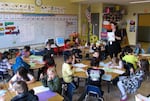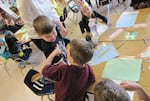
Oregon aims to graduate all of its students in the Class of 2025. Those are today’s kindergarteners.
With that in mind, OPB is starting to track kindergarteners at one school -- Earl Boyles Elementary, in east Portland’s David Douglas School District.
Earlier this year, we checked in one class of kids to see how their language skills are developing. This morning, Rob Manning looks at math.
Just after Spring Break, kindergarten teacher Cynthia Casteel gave her kindergarten students a math test. But first, she had to remind them how to take a test.

“Ok, we’re going to go ahead and start. Remember, this is a time where we are all going to be quiet, and only look at our own papers.”
Casteel is testing whether the 6-year-olds can write numbers up to 30.
They were supposed to keep their answers to themselves -- but they don’t always.
Casteel: “Then 14.”
Student: “One and a four.”
Casteel: “Oh! Don’t tell. Keep a secret.”
OK, so you can’t help your friends with the answers. How about the teacher?
Casteel: “Next -- nine.”
Student: “What does a nine look like?”
Casteel: “If you don’t know, draw an ‘x.'”
And then there’s the unexpected life-changing event unique to kindergarten -- in this case, when Chase Hutchinson loses his first tooth in the middle of writing the number “12.”
Student: “Chase broke his tooth!”

“Chase’s wiggler just came out, breaking news," Casteel laughed.
Casteel: “Let’s say, ‘congratulations Chase!’”
Students: “Congratulations Chase!”
Casteel: “And sit back down …”
Casteel would rather test one-on-one. But she has 28 students, so that takes time. And if she doesn’t take the test-taker out of the classroom -- it becomes a distraction.
“They love watching each other get tested and every time I sit one kid down, there’s five who gather around me who want to see how they do. And they want to ‘share their own knowledge’ while they’re getting tested. So it’s always a battle to get them back to what they’re supposed to be doing.”
Casteel says she assesses kids on up to 15 different math measures.
Casteel: “Now show me ten fingers -- take two away.”
Subtraction is one of the math skills she’s working on.
Casteel: “So, we’re going to read, it goes like this ‘ten minus two equals eight’. Let’s do that one more time.”
Casteel and students: “Ten minus two equals eight.”
Casteel: “Nice job, let’s turn our bodies.”
Casteel says she doesn’t hear teachers talking about Oregon’s 2025 goals of 100 percent high school graduation.
But they do talk about the national push for more rigorous standards called the "Common Core.”
It’s a K-12 effort. And Casteel says what Common Core means for kindergarten is downplaying certain math concepts -- like teaching about time and money -- and zeroing in on foundational basics.
“The goal at the end of kindergarten is that they fluently add and subtract numbers to five. And that they’re able to add and subtract numbers to ten. So we’ve had a huge focus over the past month on fluency to five with addition.”
What Casteel calls “fluency” means that kindergarteners should be able to add numbers up to five without pausing to count.
Two tables of kindergarteners are working on fluency -- one with Ms. Casteel, another with an older elementary student who comes in to volunteer. They’re playing a game with flash cards. Kids are competing to see who can solve the math problems the fastest. And they can get intense about it.
Casteel says she would consider about 60 percent of her students fluent, at least when it comes to addition.
The Common Core is controversial.
Emily Crum teaches kindergarten at another elementary school in east Portland. She's also incorporating some Common Core elements in her classroom. And she says Common Core’s emphasis on math fluency -- which emphasizes memorizing basic math equations -- has a down side.
“You know, it’s important to have a sense of fluency in math, and know your numbers and understand those concepts -- but when you’re just asking a child to memorize, it doesn’t necessarily mean they know what they’re doing, and why they’re doing it. I think we’re taking away the deeper level of thinking that happens in mathematics, when you just have them memorize stuff.”
Common Core critics are also concerned about the frequency of formal assessment that’s required -- arguing that with kindergarteners, especially, the assessments are not that useful.
Back at Earl Boyles Elementary, Cynthia Casteel does more than tests and flash card drills in math class. She uses pictures of frogs to give kids a more visual understanding of math.
Kids learn about much bigger numbers by counting the days of the school year.
Math has become a bigger national priority as part of a push for STEM – science, technology, engineering and math.
But it lacks the support that reading gets at some elementary schools – including Earl Boyles.
Casteel notes that she gets a lot more support for reading than she does for math.
“We have instructional assistants for at least 30 minutes during reading, and we also have reading intervention -- where some kids are pulled out for extra reading time. But there’s not really any extra support in place for math.”
There aren’t statewide tests for reading or math until students reach 3rd grade. And Earl Boyles' scores show students tend to test better in reading than math.
Principal Ericka Guynes acknowledges that the school needs to put more supports in place for math. She says they’re working on it.
“What we haven’t done yet is built that system clearly for math. So, in other words, you know not just benchmark testing saying ‘ok, here’s where the students fall’ in the area of math, and where they’re struggling -- maybe in number sense, or operations, or wherever the deficits are -- and then building interventions to work with those students. We have not done that yet.”
Guynes is sensitive to the balance between raising academic expectations at kindergarten while nurturing a sense of fun for a roomful of 6-year-olds. But she says kindergarteners are capable of doing of what’s expected -- especially when they come to school having some background in numbers.
